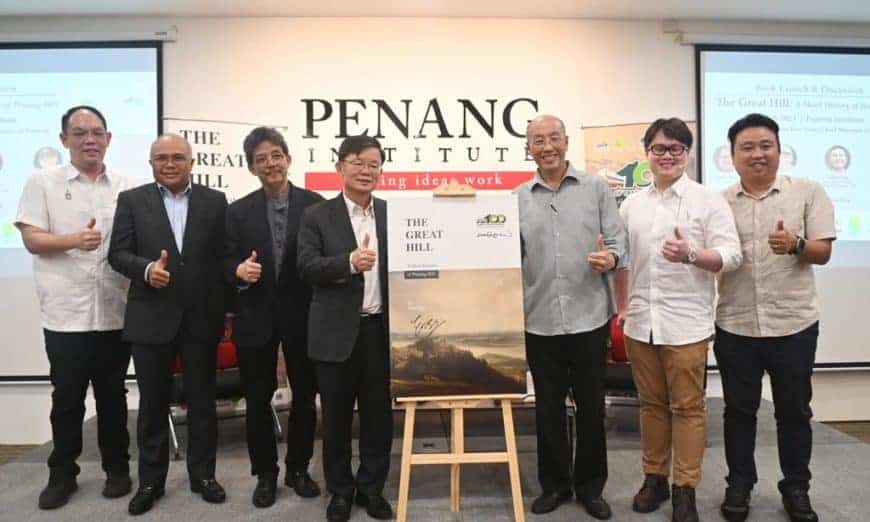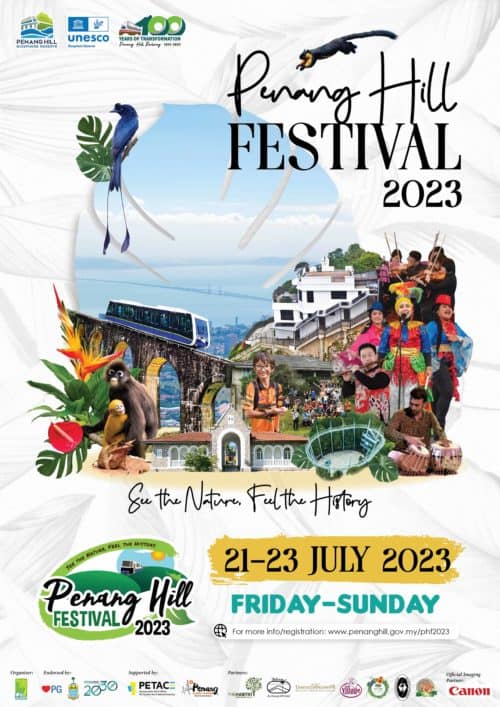ENZO Sim, the author of ‘The Great Hill’, a short story about Penang Hill, has been invited as one of the distinguished speakers at the upcoming Penang Hill Festival on July 22.
Joining him on the speaker panel are Dr Tan Chee Seng, a senior lecturer from the History Section at the School of Humanities, Universiti Sains Malaysia; and Clement Liang, president of Penang Tourist Guides Association and history lecturer.
They will talk about ‘Penang Hill & Its Vicinity – 100 years of Wonder’ at Bellevue Hotel from 9am to 11am.

The festival, organised by the Penang Hill Corporation (PHC), marks its fourth edition since its inception in 2018. This year’s festival holds special significance as PHC celebrates the centennial celebration of the hill’s iconic funicular railway.
Alongside the enlightening talks by the esteemed speakers, the festival will feature its signature event, ‘Music on the Hill – East meets West’ programme, as its conclusion on July 23 at Dataran, Penang Hill, from 3.30pm to 6.30pm.
Additionally, attendees can look forward to participating in heritage and nature discovery walks, exploring captivating exhibitions, and attending photography and videography workshops in the three-day festival from July 21 to 23.
Datuk Cheok Lay Leng, the general manager of PHC, emphasised that the talks have been thoughtfully designed to enhance people’s understanding of Penang Hill. The festival’s overarching theme is ‘See the Nature, Feel the History,’ aiming to create a deeper connection between visitors and the natural and historical aspects of Penang Hill.
Sim, a history and international politics researcher, has a lifelong interest in Southeast Asian history.
Despite being a Mass Communications graduate from KDU Penang, he has always been a history enthusiast since the tender age of eight years old when he came across his very first world map and a history book on World War II which he purchased from a book fair.
While working as a staff writer at Penang Institute, he contributed various articles to Penang Monthly that published his findings on key historical events that occurred in Penang and Malaya.
Due to his passion in documenting the history of Penang Hill, he had also singlehandedly drafted the historical contents of the funicular railway gallery at the Penang Hill Gallery after being appointed by PHC as a member of the Penang Hill Gallery consultative panel.
In 2021, he joined Joe Sidek Productions, where he curated and drafted the contents of the KL Story permanent historical gallery in Central Market KL. He also collaborated with US Library of Congress and the British Library for the BUKU2BOOKS digitised historical archive exhibition during the KLWKND Festival 2021. Furthermore, he planned the Jawi Peranakan exhibition during the Peranakan Festival 2021 and organised several other seminars.
Currently, he holds the position of Senior Copywriter at an IT company in Kuala Lumpur.

Buletin Mutiara had the opportunity to interview Sim via email on what he would share during his talk, why he wrote the book ‘The Great Hill’ and his experiences.
Below are the Q&A:
BM: What would you focus on in your talk? And why?
Sim: I will narrate the history of Penang Hill through its historical evolution which can be traced back more than 200 years ago. I will highlight its significance as the first hill station in the former British colonial empire towards the end of the 18th century.
By understanding how the Hill has evolved throughout the centuries, we will get to know the different roles that the Hill has played in the history of Penang and the formation of the surrounding social fabric, setting it apart from other historical hill stations in Malaysia, like Cameron Highlands and Fraser’s Hill, which primarily serve as leisure destinations.
For example, in the early days, the Hill originally functioned as a strategic military observation post during the Napoleonic Wars in the late 1700s, with sentinels stationed there to watch out for incoming ships from the French naval forces in the Far East threatening Penang’s (known as Prince of Wales Island then) security.
Not only that, there were also several other important roles that Penang Hill has played such as being designated as the site for the official hill residence of British governors of Penang and subsequently the Governors of Penang.
It also played a crucial role as one of the earliest education hubs in Malaya, hosting two European boarding schools, and serving as a site for high-level conference attended by British colonial officials following the Sungai Siput Estate incident, which sparked the Malayan Emergency.
BM: What inspired you to write a book specially about Penang Hill and its funicular railway?
Sim: As the first hill station to be developed in the former British colonial empire, I find it imperative to document the rich history of Penang Hill. Being a history enthusiast, my fascination for the Hill as well as the subsequent research and self-study on the Hill started far earlier before I started writing my book.
In addition to the early history of Penang Hill, which has already been covered in other books about the Hill, I wanted to shed light on the modern history of Penang Hill as well, namely the period during the Japanese Occupation, the Malayan Emergency era featuring many interesting findings that I uncovered and the recent period when the Penang Hill Corporation was formed to preserve and rejuvenate Penang Hill.
Together with the historic images that I uncovered during my search in various archives, the book, which is easy to keep in a backpack due to its size, is the perfect reading material that perfectly sums up the concise history of Penang Hill, including all the important details.
Drawing my experience and knowledge from my Mass Communications background with a deep passion for history, I know how to make history contents come alive through compelling narration. As the Malay saying goes tak kenal maka tak cinta, how will our society fall in love with such a magnificent place if they didn’t know about the history behind it?
Therefore, I sought to arouse the interest of our society, especially the younger generations, towards the history of Penang Hill through this book, which will in turn, inspire them to write about the Hill or even other interesting aspects of Malaysia’s history. Getting people to know about such history is important as it is the only way to ensure that historical landmarks like this will not be destroyed or erratically altered in the future.
BM: As Penang Hill celebrates the centennial celebration of its funicular railway, what significance does this milestone hold for you?
Sim: For a groundbreaking railway engineering feat like this to be running continuously for 100 years is an event that deserves public attention and celebration.
Being the first of its kind in Southeast Asia when it was completed in 1923, the funicular railway of Penang Hill is a proud testament to the engineering achievement of human civilisation.
What is even more remarkable is that with proper care and maintenance, a 100-year-old structure with one of the world’s steepest railway tunnels and viaducts can still serve as a mode of transportation for the local community and tourists visiting the hill.
It is significant to recognise engineers of that era, such as A.R. Johnson, who designed the railway. Their ability to overcome the various geological challenges posed by the Hill’s landscape is truly commendable.
As the classical Chinese saying goes ‘When you drink from the stream, you remember the source’; whenever I had the opportunity to travel up using the funicular railway, I always remind myself of the deliberations that A.R. Johnson and his team must have gone through. More importantly, I also reflect upon the blood, toil, tears and sweat of the Indian coolies, who carried out the laborious work of constructing the railway infrastructure.
BM: Please share some interesting stories or fascinating anecdotes that you discovered during the course of your research.
Sim: This must inarguably be the ‘haunted’ tales that I was told by several former bungalow caretakers and Public Works Department employees during the interviews!
One former caretaker of the Great Wall bungalow, built by the Chinese tycoon Khoo Sian Ewe, recounts the story of when he heard slow and heavy footsteps approaching from the stairs when he was cleaning the attic of the house where a portrait of the late owner was hung on the wall. His heartbeat raced frantically as the footsteps could be heard closer with the creaking sound of the old wooden staircase from behind only to find himself frightened by his own innocent dog, which had come up to check on its master!
The same caretaker also recalls how white powdery substances will always reappear on the walls and floors of some of the living areas of the old bungalows on the hill no matter how frequently it was cleaned. Initially perceived as something paranormal, it was only later discovered that this has to do with the history of some of these houses which were requisitioned by the Japanese army as storage depots to store provisions like salt, flour and sugar during the Japanese Occupation.
BM: What were the challenges you faced when writing the book and how did you overcome them?
Sim: The challenges of writing my book mainly came from the lack of documentation of historical events which is common in Malaysian history. Therefore, to trace back the events and the development of the Hill in the past, particularly the period before the 1960s, I had to spend a great amount of time looking through the national archives of Malaysia, Singapore, the Netherlands, and the UK.
It was definitely challenging but satisfying at the same time because searches like this will often lead to unexpected findings and new leads. Often times even when I discovered interesting archival records, such as letters, old newspapers or journals, most of them came in the form of fragmented pieces. I had to subsequently search for other archives for more clues before piecing them together like a puzzle. So the answer is to keep on searching until you find it and never be afraid to ask for help from other scholars in the field.
BM: Any specific messages that you wanted to convey to the readers of your book, ‘The Great Hill’? Any reason for choosing that title?
Sim: If there’s one message I can convey to my readers, I would like to tell them that you don’t have to be a trained professional historian to understand history or to research and write a history book. This outdated mindset is something I want to dispel, especially the stereotype towards history researchers and enthusiasts to be someone who leads a boring and secluded life spending most of their time alone in libraries. Which isn’t true. Whether the content is interesting or not, it really depends on the way the author writes it and more importantly if there’s the storytelling angles in it. So, to all readers out there, if you feel like documenting something you find interesting, just do it and you might end up being an author yourself as well, what you studied or what your career is doesn’t matter at all.
As for the title of the book, ‘The Great Hill’ was actually the original name used by the early colonial settlers in Penang while referring to Penang Hill. This shows how important it was among the early settlers of Penang and still is among the current generation of Penangites. I have the tendency to refer to places with their original name to remind people of the place’s origin.
BM: What should the state government do with regards to the funicular railway for future generations?
Many countries around the world have their own hill stations such as Dalat, Sapa, and Tam Dao in Vietnam, Bokor Hill in Cambodia, the numerous ski resorts in the Swiss Alps and Victoria Peak in Hong Kong. Some are old while others are newly built such as the case of Genting Highlands but only a few of them are served by a historical funicular railway.
Together with Penang Hill, the Victoria Peak in Hong Kong is the only one of the two hill stations in Asia Pacific that boast a historical funicular railway with the one in Hong Kong built earlier than the one in Penang in 1888. However, Penang Hill is the most unique of all as the Penang state government, through the PHC, has helped preserved and retained many of the original architectures and railway infrastructures while the Victoria Peak in Hong Kong has been heavily modified with many of the original structures having been demolished such as the summer residence of the British Hong Kong governor.
Therefore, I truly believe that the Penang state government is following the right path and should continue to preserve and restore the state-owned bungalows in Penang Hill and readapt them for other usages.
A prime example is the successful transformation of the Edgecliff bungalow into the Penang Hill Gallery, a project to which I had the privilege of contributing as a curator.
Throughout its history since its opening in 1923, the funicular railway has undergone two major overhauls, in 1977 and 2010, to accommodate the increasing number of passengers. These changes have brought convenience to commuters as it has significantly shortened the waiting and travelling time of the funicular ride.
As long as the original structures and the nature of the Hill are not endangered, I will welcome any sort of proposals from the state government to improve the accessibility of the Hill, including constructing the proposed cable car project which will help reduce the congestion of the funicular railway.
Story by K.H. Ong
Pix by Alissala Thian and courtesy of Penang Hill Corporation

